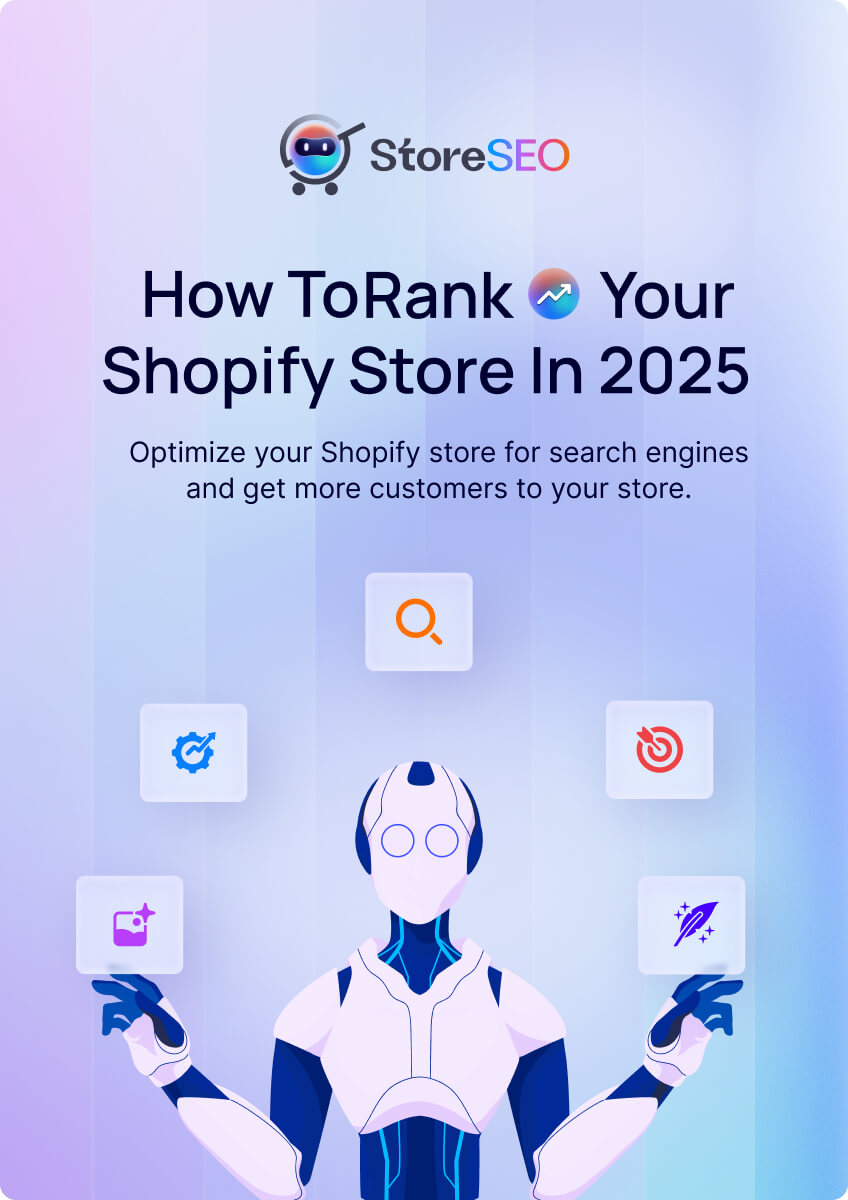AIを活用した検索は、 オンラインストアが発見される. 従来のSEOだけでは、もはや可視性を保証することはできません。Shopifyストアは、人間と同様に機械の言語で対応する必要があります。そこでAEO(Answer Engine Optimization:検索エンジン最適化)とGEO(Google外部出力)が役立ちます。AIシステムがコンテンツを解釈、要約、推奨する方法に合わせてストアを設計することで、検索結果だけでなく、検索結果内でも存在感を確保できます。ShopifyストアをAI検索向けに最適化する方法を見ていきましょう。.

AI時代のAEOとGEOを理解する
これらのコンセプトは、人工知能が検索エンジンや回答エンジンにますます力を入れている環境で目立つための鍵となります。.
AEO ChatGPTやGoogle AIなどのAI搭載回答エンジンが迅速かつ明確な回答を提供するように、コンテンツを最適化することがAEOの目的です。クリック数によるページのランキング付けに重点を置く従来のSEOとは異なり、AEOは、AIによる要約や音声アシスタントに表示される、信頼できる簡潔な回答としてコンテンツが選ばれることを目指します。.
これは、AIが理解できる方法でコンテンツを構造化することを意味します。例えば、実際のユーザーからの質問を含むFAQセクションの作成、明確で簡潔な回答ブロックの使用、製品とFAQへのスキーママークアップの適用などです。AEOは基本的に、コンテンツをAI対応にすることで、ユーザーがウェブサイトをクリックすることなく即座に回答を求めるゼロクリック環境にもコンテンツを表示できるようにします。.

一方で、 ジオ Grok、Perplexity、ChatGPT などの生成 AI 検索エンジンで使用されるようにコンテンツとブランド情報がどのように準備され、構造化されるかに焦点を当てています。これらの検索エンジンは質問に答えるだけでなく、製品の推奨、要約、会話形式の返信も生成します。.
GEOは、クリーンで構造化された製品データ、自然で説明的な言語、文脈に富んだコンテンツ、そしてユーザーが尋ねそうな会話のプロンプトを予測することに重点を置いています。GEOは、AIシステムが時間の経過とともにどのようにデータを「認識」し、活用するかを管理することで、企業がAIによって生成された応答内で自社の存在と正確な表現を確保できるよう支援します。.

eコマースにおいて、AEOとGEOを組み合わせることで、大きなメリットが生まれます。AEOは、直接的な質問主導の検索意図を持つユーザーを捉えるのに役立ちます。一方、GEOは、AIが生成したコンテンツやレコメンデーションにおいて、商品やブランドが明確かつ正確に表示されることを保証します。.
これらの戦略を組み合わせることで、従来の検索、AI チャット インターフェース、音声アシスタント全体の可視性が向上し、AI 主導の購入者に明確で信頼できる最新の情報を提供することで、適格なトラフィックを促進し、コンバージョン率を向上させることができます。.
Shopifyストア向けのAEO戦略
トップ ShopifyのAEO(アンサーエンジン最適化)戦略 ストアは、AIを活用した回答エンジンがあなたのECサイトを理解しやすく、好んで利用してくれるようにすることに重点を置いています。このアプローチにより、音声検索、強調スニペット、AIによる商品レコメンデーションにおいて、あなたのストアが最適な回答として表示されるようになります。ここでは、AEO戦略の鍵となる重要な点を分かりやすく解説します。.
会話的で明確なコンテンツを書く
AEOは、会話のように自然で分かりやすいコンテンツで成功します。ページをキーワードで埋め尽くすのではなく、質疑応答形式を採用しましょう。例えば、「この商品のメリットは何ですか?」や「使い方は?」など、顧客がよくある質問に回答することで、AIエンジンがサイトを素早く見つけ出し、役立つリソースとして表示しやすくなります。回答は簡潔に、各質問のすぐ下に配置することで、効果を最大限に高めることができます。.
構造化データとスキーママークアップを使用する

構造化データは、サイトに追加される技術情報で、AIが商品やコンテンツをより深く理解するのに役立ちます。Shopifyでは、 SEO スキーママークアップ FAQ、製品詳細、ハウツーガイドなど。このマークアップは、AIにページの内容を正確に伝えるため、リッチスニペットや音声検索結果に表示される可能性が高まります。適切なスキーマを追加することで、AIによる回答の可視性が向上します。.
製品ページにFAQセクションを作成する
よくある質問(FAQ)はAEOに最適です。商品ページに詳細なQ&Aブロックを掲載し、顧客からのよくある質問に回答しましょう。これらのFAQは、買い物客が自然に抱く疑問を的確に捉え、会話型検索キーワードでのページのランキング向上に役立ちます。この戦略は、買い物客が重要な情報に簡単にアクセスできるようにすることで、ユーザーエクスペリエンスの向上にもつながります。.
トピックコンテンツクラスターを作成する
関連商品やブログ投稿をサイト上のテーマ別にまとめ、クラスター化しましょう。例えば、ウェルネス商品を販売するストアであれば、「環境に優しいキャンドル」や「睡眠のためのハーブサプリメント」といったテーマでコンテンツを整理できます。AIシステムは、クラスター化されたコンテンツによって明確なコンテキストが得られ、関連情報を紐付けやすくなるため、高く評価します。クラスター化によって、特定のトピックにおけるサイトのオーソリティが強化され、AEO(検索エンジン最適化)のパフォーマンスが向上します。.
音声検索に最適化

AEOは 音声アシスタント, 会話調の言葉遣いと簡潔で直接的な回答を用いて、音声検索向けにコンテンツを最適化しましょう。音声検索は入力によるものよりも長く自然な表現になることが多いため、文章もこのスタイルに合わせてください。複雑な文や専門用語は避け、音声エンジンがスムーズに回答を伝達できるようにしましょう。.
内部リンクを使用する
サイト内の関連ページを内部リンクで繋ぎましょう。商品ページをブログやカテゴリーページにリンクすることで、AIはコンテンツ間の関連性を理解しやすくなります。これにより、ウェブサイトの様々な部分から抽出されたAI生成の回答に、あなたの商品が表示される可能性が高まります。.
コンテンツを定期的に監視して更新する
AEOには継続的な取り組みが必要です。コンテンツを定期的に監査し、インプレッション数は多いもののクリック数が少ないページを特定し、より明確な回答、FAQの更新、スキーマの強化などによってそれらのページを改善しましょう。コンテンツを常に新鮮で関連性のある状態に保つことで、AIによる検索結果で高いランキングを維持することができます。.
ユーザー生成コンテンツを追加する

レビュー、ユーザーからの質問、そしてお客様の声は、買い物客の一般的な懸念に答える、自然でリアルなコンテンツです。こうしたコンテンツは、本物の言葉と経験を反映しているため、AEOにとって価値があり、AIがあなたのサイトを信頼できるユーザー重視のサイトであると認識するのに役立ちます。.
モバイル最適化と高速読み込み

AEOは、以下のサイトを優先します。 モバイルデバイスで優れたパフォーマンスを発揮. Shopifyストアの読み込み速度が速く、スマートフォンやタブレットでも操作しやすいようにしましょう。高速でレスポンシブなデザインは、ストアをユーザーの行動に合わせて調整し、AIエンジンがページを優先的に表示する確率を高めます。.
Shopifyストア向けのトップGEO戦略
Shopifyストア向けの主要なGEO戦略は、従来のSEOと整合性を保ちつつ、AI搭載検索エンジンや生成AIシステムによってストアが発見され、好まれるよう最適化することに重点を置いています。Shopifyストアオーナーが検討すべき、分かりやすく説明された重要な戦略をいくつかご紹介します。
ユーザーの意図とコンテキストを優先する
キーワードをターゲットにするだけでなく、顧客が真に求めているものを理解することに集中しましょう。最新のAIを活用した検索は、クエリの背後にある意図とコンテンツの文脈を重視します。顧客があなたの商品に関して抱くであろう「なぜ」や「どのように」といった疑問に答えることで、あなたのストアはより関連性の高い、思慮深い方法で表示されるようになります。.
EEATガイドラインの実装
EEATは、専門知識(Expertise)、経験(Experience)、権威(Authoritativeness)、信頼性(Trustworthiness)の頭文字をとったものです。質の高いコンテンツ、著者プロフィール、顧客レビュー、ブランド情報などを通して、専門知識を明確に示すことが重要です。これにより、検索エンジンと顧客の両方からの信頼が構築され、信頼性とランキングが向上します。.
SEOとGEO戦略を組み合わせる
キーワード調査やリンク構築といった従来のSEOのベストプラクティスを無視しないでください。むしろ、構造化されたAIが読み取れるコンテンツとセマンティックリッチネスに重点を置いたGEOアプローチと組み合わせましょう。例えば、コンテンツを関連トピックを中心としたテーマ別のクラスターに整理することで、AIがストアのオファーをより深く理解できるようになります。.
地域固有のページとコンテンツを作成する
Shopifyストアが複数の地域にサービスを提供している場合は、各地域専用のページを作成し、地域特有のキーワードや情報を自然に盛り込みましょう。例えば、都市名、地元のランドマーク、地域限定のセール情報などを掲載するなどです。これらのページは、位置情報に基づいた検索での露出度を高めます。.
自然言語と会話形式の文章を活用する
製品の説明、ブログコンテンツ、FAQは、顧客が実際に話すような自然で分かりやすい言葉で作成しましょう。これにより、SEOエンジンとGEOエンジンがコンテンツを実際のユーザーの検索クエリと効果的にマッチングしやすくなります。.
地理的キーワード調査を使用する
都市名、地区名、「近くの」フレーズなどの地理的な用語と組み合わせたキーワードを調査し、活用しましょう。これらの地理的なキーワードを含めることで、商品名と説明文を最適化し、地元の買い物客とのつながりを強化しましょう。.
地元のレビューや体験談を活用する
特定の場所について言及した顧客のレビューや体験談を盛り込みましょう。これにより、信頼関係が構築されるだけでなく、ページに現地のリアルなコンテキストが加わり、位置情報に基づく検索クエリの関連性が向上します。.
データとワークフロー管理の自動化
Shopify Flowなどのツールを活用して、タグ付け、商品の分類、顧客のセグメンテーションを自動化しましょう。正確で整理された情報があればAIはより優れたパフォーマンスを発揮するため、GEOの成功にはクリーンで構造化されたデータが不可欠です。.
パフォーマンスを監視して調整する
ローカル検索ランキング、地域からのトラフィック、コンバージョン率といった主要業績評価指標(KPI)を追跡します。ローカライズされたページでA/Bテストを実施し、見出し、CTA、コンテンツを最適化してエンゲージメントを向上させます。.
Shopifyストア向け実践的なAEOおよびGEO最適化チェックリスト
Shopifyストアを最適化するための実用的なチェックリストは次のとおりです。 AEO (回答エンジン最適化)と ジオ (生成エンジン最適化)最近の洞察に基づいた戦略:
AEO(回答エンジン最適化)フォーカス
- 顧客の意図に基づいた会話形式の質問を特定し、ターゲットにします。.
- 製品、コレクション、ブログページの FAQ に対して、明確かつ直接的で簡潔な回答を作成します。.
- AI がコンテンツを理解できるように、構造化データ (JSON-LD スキーマ マークアップ)、特に FAQ と製品スキーマを実装します。.
- 自然なユーザークエリに合わせて、コンテンツ内で会話形式の言語を使用します。.
- コンテンツが特定の質問に答えていることを確認して、注目のスニペット、ナレッジパネル、AI 生成のクイック回答をトリガーします。.
- 関連性と正確性を保つために、FAQ セクションを定期的に監査して更新します。.
GEO(生成エンジン最適化)フォーカス
- ブランドまたは主力製品ラインを表す単一の標準的なメイン エンティティを構築して管理します。.
- AI のクロスサーフェス推論を維持するために、すべてのロケールと言語のバリエーションをスキーマに正しく添付します。.
- GEO テンプレートを作成して、製品の詳細、プロモーション、FAQ が AI インターフェースや音声アシスタントにどのように表示されるかを定義します。.
- ガイド、チュートリアル、専門家のまとめ、ニッチに関連するテーマ別クラスターなど、長文の信頼できるコンテンツを開発します。.
- ブログとコレクションのコンテンツを最適化して、セマンティックグループ化に基づいてトピックの権限クラスターを形成します。.
- 簡潔で信頼性の高いコンテンツ フラグメントをエッジで事前に計算してキャッシュし、AI クエリのレイテンシを削減します。.
- すべてのコンテンツ更新が、出所、所有権メモ、および説明可能性によって監査可能であることを確認し、簡単にロールバックできるようにします。.
- EEAT パリティ (専門知識、経験、権限、信頼性)、アクセシビリティ、レイテンシー、およびユーザー エクスペリエンスのメトリックを追跡するダッシュボードを使用します。.
- 多言語ストアフロントを拡張し、言語やデバイスに関係なく一貫性と迅速な配信を保証します。.
AIの可視性を解き放つ:Shopifyの成功のためのAEOとGEO戦略
AEOとGEOの技術導入はもはやオプションではありません。AI主導の検索と発見という新時代において、Shopifyストアを将来も確実に備えた状態にするための鍵となるのです。サイト構造を洗練し、構造化データを統合し、顧客の意図に直接応えるコンテンツを作成することで、従来の検索エンジンだけでなく、ジェネレーティブエンジンでもストアが検索結果に表示され、おすすめされるようになります。AI検索は、明確で、高速で、真に役立つストアを評価します。そのため、最適化戦略を今すぐ転換することは、ランキングの向上だけでなく、より深い顧客エンゲージメントと持続的な可視性の向上にもつながります。.
私たちのブログは役に立ったでしょうか?もしそうなら、 ブログを購読する 業界関連のトピックに関するその他のヒント、チュートリアル、最新情報については、こちらをご覧ください。








